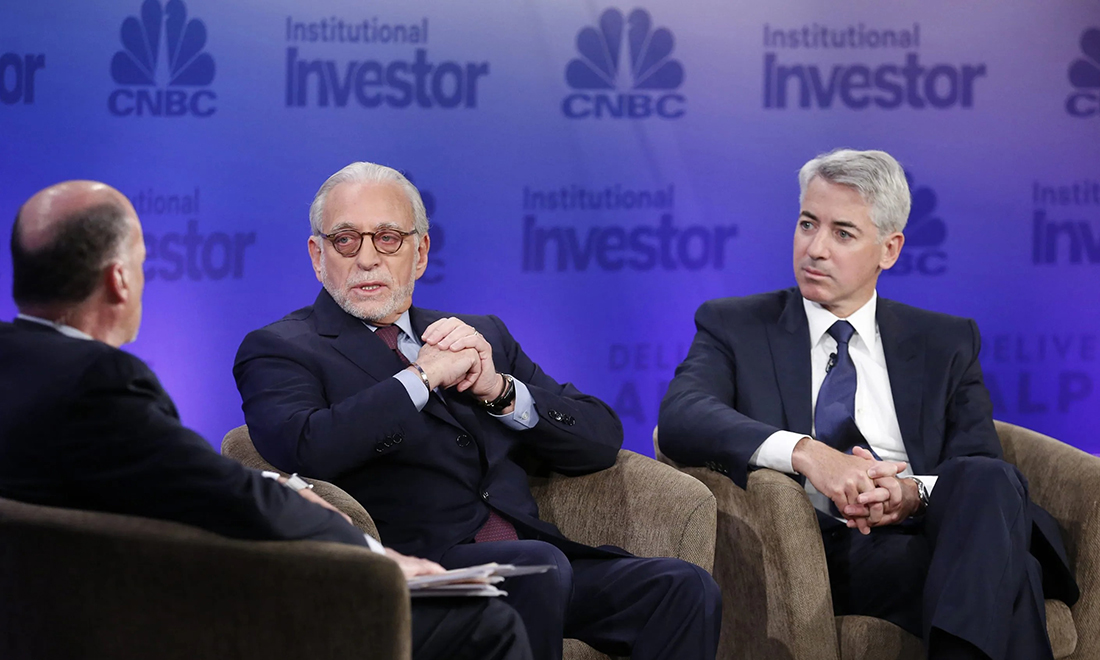
美联储(Federal Reserve)的主席杰罗姆·鲍威尔在5月3日的新闻发布会上安抚美国人民称:“美国的银行体系是强大的,是有抗风险能力的”,并表示自今年3月硅谷银行(Silicon Valley Bank)和签名银行(Signature Bank)倒闭以来,银行业的状况已经有了“普遍改善”。然而在当天的盘后交易中,多家地区性银行股价暴跌,显然表明市场对他的话并没有什么信心。
例如,西太平洋银行公司(PacWest Bancorp)宣布,该公司正在探索“战略选项”,包括出售都是有可能的。消息一出,该公司的其股价暴跌了30%以上。另外,在美国第一共和银行(First Republic Bank)刚刚崩盘后,美联储在5月3日仍然宣布将继续加息至2007年以来的最高水平,受此消息影响,美国银行板块出现了普遍的下跌。美联储的这一决定让最有经验的投资者都感到了紧张,业界纷纷预测美国将有更多的地区性银行爆雷。
DoubleLine Capital的联合创始人及首席执行官杰弗里·冈拉克在接受美国消费者新闻与商业频道(CNBC)采访时表示,由于美联储不顾地区性银行的安危坚持加息,他对市场“肯定是更加看空了”。
他警告道:“在我看来,储蓄肯定是会继续外流的。加息肯定会导致压力的持续加大。我认为很有可能会出现更多的地区性银行爆雷。”
在美联储坚持加息的情况下,担心地区性银行的生存和健康问题的远不止冈拉克一个人。5月3日,潘兴广场资本管理公司(Pershing Square Capital Management)的创始人及首席执行官比尔·阿克曼也在推特(Twitter)上写道:“地区银行体系目前正面临风险,留给我们解决这个问题的时间不多了。”
5月4日,随着恐慌情绪在金融领域再次蔓延,追踪美国地区性银行板块的基金SPDR S&P Regional Banking ETF截至午盘下跌近7%。自3月1日以来,该基金已经下跌逾40%。
该板块最近一轮抛售的导火索,是西太平洋银行公司在5月3日宣布可能出售的消息引发的。自从今年3月硅谷银行和签名银行崩盘以来,西太平洋银行公司(总部位于美国加利福尼亚州)一直承受较大的下行压力,5月4日早盘一度下跌60%,最终因为反复波动而停牌。田纳西州的第一地平线银行(First Horizon Bank)在终止了与TD银行(TD Bank)的合并协议后,股价也下跌了近40%。菲尼克斯的西部联盟银行(Western Alliance Bancorp)的股价一度暴跌60%,后因为传言它可能被出售而有所回升,但该银行随即否认了出售传闻。
阿克曼指出,这些地区性银行正在因为加息导致的“资产受损”问题而苦苦挣扎。与此同时,美国国债甚至苹果公司(Apple)最新推出的存款账户也分流了这些地区性银行的不少存款。
为了提振投资者对这些地区性银行的信心,阿克曼认为,所有存款人不论有没有保险,都应该获得美国联邦存款保险公司(FDIC)的支持。“美国联邦存款保险公司没有升级和扩大其保险机制,从而给棺材上钉了更多的钉子。”他还表示,如果第一共和银行的储户当时得到了美国联邦存款保险公司的保护,这家银行或许就不会倒闭。
“银行业是一场信心的游戏。按照现在的这种速度,没有一家地区性银行能够挺过什么坏消息或者坏数据。”
美国财政部的部长珍妮特·耶伦在今年3月对参议院拨款委员会(Senate Appropriations Committee)表示,她不会考虑为银行提供“全面保险”。不过在当月晚些时候,她在对美国银行家协会(American Bankers Association)的一次讲话中指出,如果小型银行机构出现储户挤兑风险,并且“造成了蔓延性风险”,那么她可能就会介入,为储户提供支持。
特里安基金管理公司(Trian Fund Management)的联合创始人及首席执行官纳尔逊·佩尔茨也在上周称,除非美国联邦存款保险公司和美国财政部为有保险和没有保险的储户都提供支持,否则可能就会有更多地区性银行面临倒闭风险。他告诉《金融时报》(Financial Times),这是唯一可以“阻止小型地区性和社区银行存款外流”的办法。他还表示:“我们并不希望所有资金都流向大型银行。”
第一共和银行崩盘后,摩根大通(JPMorgan Chase)及时出手接盘,接下了它1,730亿美元的贷款、300亿美元的证券和920亿美元的存款。分析师称赞此举是摩根大通股东梦寐以求的一幕。但佩尔茨则认为,地区性银行对美国经济的健康发挥着至关重要的作用。对于这个问题,《财富》杂志以前曾经专文论述过。
佩尔茨说:“我们是少数几个拥有庞大的小型地区性银行和社区银行网络的国家之一。在过去100多年里,它们满足了大量中小企业的需求,我认为我们承担不起它们倒闭的代价。”
他还表示:“我认为,地区性银行是美国很多公司和房地产业的支柱”,而为存款提供保险则是“让它们继续保持实力和影响力的途径”。(财富中文网)
译者:朴成奎
美联储(Federal Reserve)的主席杰罗姆·鲍威尔在5月3日的新闻发布会上安抚美国人民称:“美国的银行体系是强大的,是有抗风险能力的”,并表示自今年3月硅谷银行(Silicon Valley Bank)和签名银行(Signature Bank)倒闭以来,银行业的状况已经有了“普遍改善”。然而在当天的盘后交易中,多家地区性银行股价暴跌,显然表明市场对他的话并没有什么信心。
例如,西太平洋银行公司(PacWest Bancorp)宣布,该公司正在探索“战略选项”,包括出售都是有可能的。消息一出,该公司的其股价暴跌了30%以上。另外,在美国第一共和银行(First Republic Bank)刚刚崩盘后,美联储在5月3日仍然宣布将继续加息至2007年以来的最高水平,受此消息影响,美国银行板块出现了普遍的下跌。美联储的这一决定让最有经验的投资者都感到了紧张,业界纷纷预测美国将有更多的地区性银行爆雷。
DoubleLine Capital的联合创始人及首席执行官杰弗里·冈拉克在接受美国消费者新闻与商业频道(CNBC)采访时表示,由于美联储不顾地区性银行的安危坚持加息,他对市场“肯定是更加看空了”。
他警告道:“在我看来,储蓄肯定是会继续外流的。加息肯定会导致压力的持续加大。我认为很有可能会出现更多的地区性银行爆雷。”
在美联储坚持加息的情况下,担心地区性银行的生存和健康问题的远不止冈拉克一个人。5月3日,潘兴广场资本管理公司(Pershing Square Capital Management)的创始人及首席执行官比尔·阿克曼也在推特(Twitter)上写道:“地区银行体系目前正面临风险,留给我们解决这个问题的时间不多了。”
5月4日,随着恐慌情绪在金融领域再次蔓延,追踪美国地区性银行板块的基金SPDR S&P Regional Banking ETF截至午盘下跌近7%。自3月1日以来,该基金已经下跌逾40%。
该板块最近一轮抛售的导火索,是西太平洋银行公司在5月3日宣布可能出售的消息引发的。自从今年3月硅谷银行和签名银行崩盘以来,西太平洋银行公司(总部位于美国加利福尼亚州)一直承受较大的下行压力,5月4日早盘一度下跌60%,最终因为反复波动而停牌。田纳西州的第一地平线银行(First Horizon Bank)在终止了与TD银行(TD Bank)的合并协议后,股价也下跌了近40%。菲尼克斯的西部联盟银行(Western Alliance Bancorp)的股价一度暴跌60%,后因为传言它可能被出售而有所回升,但该银行随即否认了出售传闻。
阿克曼指出,这些地区性银行正在因为加息导致的“资产受损”问题而苦苦挣扎。与此同时,美国国债甚至苹果公司(Apple)最新推出的存款账户也分流了这些地区性银行的不少存款。
为了提振投资者对这些地区性银行的信心,阿克曼认为,所有存款人不论有没有保险,都应该获得美国联邦存款保险公司(FDIC)的支持。“美国联邦存款保险公司没有升级和扩大其保险机制,从而给棺材上钉了更多的钉子。”他还表示,如果第一共和银行的储户当时得到了美国联邦存款保险公司的保护,这家银行或许就不会倒闭。
“银行业是一场信心的游戏。按照现在的这种速度,没有一家地区性银行能够挺过什么坏消息或者坏数据。”
美国财政部的部长珍妮特·耶伦在今年3月对参议院拨款委员会(Senate Appropriations Committee)表示,她不会考虑为银行提供“全面保险”。不过在当月晚些时候,她在对美国银行家协会(American Bankers Association)的一次讲话中指出,如果小型银行机构出现储户挤兑风险,并且“造成了蔓延性风险”,那么她可能就会介入,为储户提供支持。
特里安基金管理公司(Trian Fund Management)的联合创始人及首席执行官纳尔逊·佩尔茨也在上周称,除非美国联邦存款保险公司和美国财政部为有保险和没有保险的储户都提供支持,否则可能就会有更多地区性银行面临倒闭风险。他告诉《金融时报》(Financial Times),这是唯一可以“阻止小型地区性和社区银行存款外流”的办法。他还表示:“我们并不希望所有资金都流向大型银行。”
第一共和银行崩盘后,摩根大通(JPMorgan Chase)及时出手接盘,接下了它1,730亿美元的贷款、300亿美元的证券和920亿美元的存款。分析师称赞此举是摩根大通股东梦寐以求的一幕。但佩尔茨则认为,地区性银行对美国经济的健康发挥着至关重要的作用。对于这个问题,《财富》杂志以前曾经专文论述过。
佩尔茨说:“我们是少数几个拥有庞大的小型地区性银行和社区银行网络的国家之一。在过去100多年里,它们满足了大量中小企业的需求,我认为我们承担不起它们倒闭的代价。”
他还表示:“我认为,地区性银行是美国很多公司和房地产业的支柱”,而为存款提供保险则是“让它们继续保持实力和影响力的途径”。(财富中文网)
译者:朴成奎
Federal Reserve Chairman Jerome Powell attempted to reassure Americans that “the U.S banking system is sound and resilient” at an afternoon press conference on May 3, arguing conditions in the sector have “broadly improved” since the collapse of Silicon Valley Bank and Signature Bank in March. But his message was undercut by a plunge in multiple regional bank stocks in after-hours trading.
Shares of PacWest Bancorp, for example, tumbled more than 30% after the lender announced that it is exploring “strategic options” for its business, including a potential sale. And there were also broad declines in the sector in response to the Fed’s announcement earlier in the day that it would be hiking interest rates to their highest level since 2007, even in the face of recent banking instability highlighted by the failure of First Republic Bank just last week. It’s a decision that has left even the most seasoned of investors feeling nervous and predicting further regional bank drama.
Jeffrey Gundlach, the billionaire cofounder and CEO of DoubleLine Capital, told CNBC Wednesday that he’s definitely “turning more bearish” after the Fed decided to raise rates despite regional banks’ latest issues.
“It just seems to me that deposits are going to keep drifting out,” he warned. “Leaving rates this high is going to continue this stress. I believe with a very high degree of probability there’s going to be further regional bank failures.”
And Gundlach is far from alone in his concerns about the health and prospects of regional banks amid rising rates. “The regional banking system is at risk,” Bill Ackman, founder and CEO of Pershing Square Capital Management, tweeted on May 3. “We are running out of time to fix this problem.”
On May 4, we got a taste of what the billionaires were talking about as contagion fears reignited in the financial sector, leading the SPDR S&P Regional Banking ETF, which tracks U.S. regional bank stocks, to fall nearly 7% by midday. The fund is now down over 40% since March 1.
The latest selloff was sparked by PacWest Bancorp’s potential sale announcement on May 3. Shares of the California-based lender, which has been under pressure since the failure of its peers Silicon Valley Bank and Signature Bank in March, dropped as much as 60% in early trading on May 4 and were halted for volatility multiple times. Tennessee-based First Horizon also sank nearly 40% after terminating its merger agreement with the regional TD Bank, and Phoenix-based Western Alliance Bancorp plummeted as much as 60% before paring some of its losses amid rumors, which it denies, of a potential sale.
Ackman noted that these regional banks are struggling to cope with rising interest rates that have “impaired assets,” and at the same time they’re facing increased competition for deposits from Treasuries and even Apple’s new savings account.
To boost investor confidence in the ailing banks, the billionaire believes all depositors, both insured and uninsured, should be backstopped by the FDIC. “The [FDIC’s] failure to update and expand its insurance regime has hammered more nails in the coffin,” he wrote, arguing First Republic wouldn’t have failed if its depositors were protected.
“Banking is a confidence game,” he added. “At this rate, no regional bank can survive bad news or bad data.”
Treasury Secretary Janet Yellen told the Senate Appropriations Committee in March that she will not consider “blanket insurance” for banks, but in a speech to the American Bankers Association later that month she noted that if smaller institutions face depositor runs and “pose the risk of contagion,” she would step in and backstop depositors.
Nelson Peltz, cofounder and CEO of Trian Fund Management, also argued last week that more regional banks are likely to fail unless the FDIC and Treasury backstop both insured and uninsured depositors. That’s the only thing that will “stop the deposit outflow from the small regional and community banks,” he told the Financial Times in an interview published on May 4, adding: “I don’t think we want all of the funds just going to major banks.”
JPMorgan Chase was able to scoop up the assets of First Republic, including $173 billion of loans, $30 billion of securities, and $92 billion of deposits, after its collapse last week in a move analysts have lauded as a dream scenario for the megabank’s shareholders. But Peltz warned, as Fortune has previously reported, that regional banks in the U.S. are critical to the health of the economy.
“We’re one of the few countries that has a large infrastructure of small regional and community banks,” he said. “They have filled the needs of small businesses for well over a hundred years—I believe we can’t afford to let them go.”
“I believe regional banks are the backbone of many companies and real estate across the U.S.,” he added, arguing that backstopping deposits “is the way to give them continued influence and strength.”






